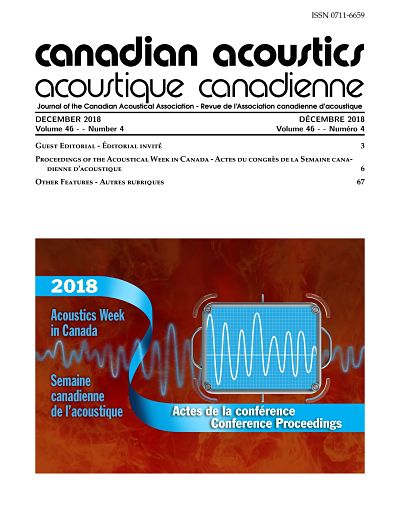Single-Channel Vibrotactile Feedback For Voicing Enhancement In Trained And Untrained Perceivers
Keywords:
HAPTICS, HAPTIQUE, SPEECH PERCEPTION, PERCEPTION DE LA PAROLE, SPEECH INTELLIGIBILITY, INTELLIGIBILITÉ DE LA PAROLEAbstract
Speech intelligibility can be enhanced by integrating information from other modalities, e.g., vision (Sumby & Pollack 1954) or direct manual touch (Gick et al. 2008). There are, nonetheless, many circumstances where shared visual attention may be hard to establish, or where in-person contact may be infeasible (e.g., in a noisy collaborative environment). We use vibrotactile feedback to enhance intelligibility in acoustically noisy conditions by providing stimulation in a manner similar to the laryngeal vibrations felt during voiced speech. Participants were asked to discriminate between words in noise, distinguished in voicing and vowel height. In a pilot study we contrasted vibrator placement (fingers vs. neck) with different vibration styles. In untrained perceivers we found that vibrotactile feedback increased accuracy regardless of placement. This effect, though significant, was not strong enough to be useful for everyday speech enhancement. We then conducted a full study using trained participants and found strong evidence for vibrotactile enhancement of speech intelligibility in acoustically noisy environments.Additional Files
Published
How to Cite
Issue
Section
License
Author Licensing Addendum
This Licensing Addendum ("Addendum") is entered into between the undersigned Author(s) and Canadian Acoustics journal published by the Canadian Acoustical Association (hereinafter referred to as the "Publisher"). The Author(s) and the Publisher agree as follows:
-
Retained Rights: The Author(s) retain(s) the following rights:
- The right to reproduce, distribute, and publicly display the Work on the Author's personal website or the website of the Author's institution.
- The right to use the Work in the Author's teaching activities and presentations.
- The right to include the Work in a compilation for the Author's personal use, not for sale.
-
Grant of License: The Author(s) grant(s) to the Publisher a worldwide exclusive license to publish, reproduce, distribute, and display the Work in Canadian Acoustics and any other formats and media deemed appropriate by the Publisher.
-
Attribution: The Publisher agrees to include proper attribution to the Author(s) in all publications and reproductions of the Work.
-
No Conflict: This Addendum is intended to be in harmony with, and not in conflict with, the terms and conditions of the original agreement entered into between the Author(s) and the Publisher.
-
Copyright Clause: Copyright on articles is held by the Author(s). The corresponding Author has the right to grant on behalf of all Authors and does grant on behalf of all Authors, a worldwide exclusive license to the Publisher and its licensees in perpetuity, in all forms, formats, and media (whether known now or created in the future), including but not limited to the rights to publish, reproduce, distribute, display, store, translate, create adaptations, reprints, include within collections, and create summaries, extracts, and/or abstracts of the Contribution.


